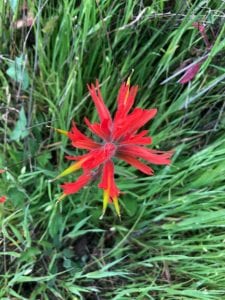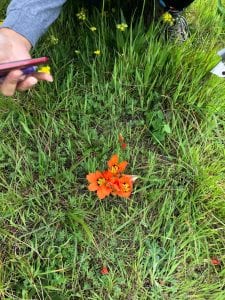So during this field trip is when all of us had our first field exam! The night before I didn’t get much sleep and I ended up falling over quite a few times during the trip. I’ll have to tell myself to be more responsible next time! Because of the exam we didn’t get to see as many plants as usual but it was still relatively beautiful outside. The Marin headlands are pretty near the coast so most of the plants we saw there coastal in nature. However, we did see a couple of trees and other things especially as climbed up the cliffs to higher elevation.
Unfortunately, there weren’t really that many plants we could’ve eaten along the trip, however, that didn’t stop me from eating dirt all along the trail. Instead, you guys will just have to settle for some beautiful flowers !
****
Franciscan Paintbrush
The Franciscan Paintbrush is perhaps one of the most beautiful flowers I have ever seen. It has very distinctive and vibrant colors to it. In fact, the colors on it were so vibrant that they are actually the subject of a very popular children’s book called ‘The Legend of The Indian Paintbrush’. I actually remembered reading this book when I was little. Basically its the story of a boy who chose to become an artist instead of a warrior because he was really good at it and ended up painting extremely beautiful things. You can check out the youtube video of it below. In addition to being the subject of a children’s book, this flower also happens to be particularly useful at absorbing selenium (which is a toxic heavy metal) from the ground. Lastly, the plant is also semi-parasitic and has been known to take nutrients from nearby plants.
Plant description: The Franciscan Paintbrush (Castilleja Subinclusa) is a perennial herb which can grow up to 120 centimeters tall! On the stem, there are often many short axillary shoots. Leaves are 30-80 mm in length and have a lanceolate apex shape. They can have 0 to three lobes in their leaves and they often curl upwards at the end. The inflorescence is characteristically long. This subspecies generally has a yellow to orange corolla with bright red sepals. This plant does use seeds to reproduce but may also utilize rhizomes.
****
Yellow Monkeyflower
This next flower just has something about that you can’t quite put your finger on. Its shape is so unique that you kind of go home with a weird feeling thinking you’ve just been pranked because it looks so different. The yellow monkeyflower doesn’t really look like monkey’s face but it certainly does seem to have a quality of mischief surrounding it. Fun facts about the monkey flower include that its leaves actually store sodium chloride in them. Some people actually used to use their leaves as a substitute for expensive salt. One species of the monkey flower genus is actually carnivorous and traps insects. Lastly, some people used this plant as a poultice for its antibacterial properties. I guess the monkey flower isn’t just mischievous! (But I still wouldn’t trust it as a poultice).
Plant description: The yellow monkeyflower (Erythranthe guttata) is a perennial herb that can be either glabrous or hairy. Its roots can spread through rhizomes as well as seeds. The leaf margin of the flower is crenate. Its shape is ovate to round and can be irregularly dissected. It also has a short petiole. The inflorescence is raceme although sometimes there may only be one flower on the plant. The corolla is characteristically yellow and irregularly lobed. The tube-throat of the flower can reach up to 20mm long.
****
Harlequin Flower
Much like the name suggests, this flower is definitely scandalous! It has a very distinctive beautiful corolla with 3 bright different colors. These plants are actually native to South Africa but have become popular enough in gardens to have spread to Australia and California.
Plant description: The habit of the harlequin flower is that it a herbaceous perennial monocot. The stems are generally erect. The leaves of the plant are usually basal with a parallel like venation and an entire margin. The perianth generally appears in one whorl unlike many other members of the Iridaceae family. The fruit is capsule like. The flowering time for this plant is generally narrow from march to april.




